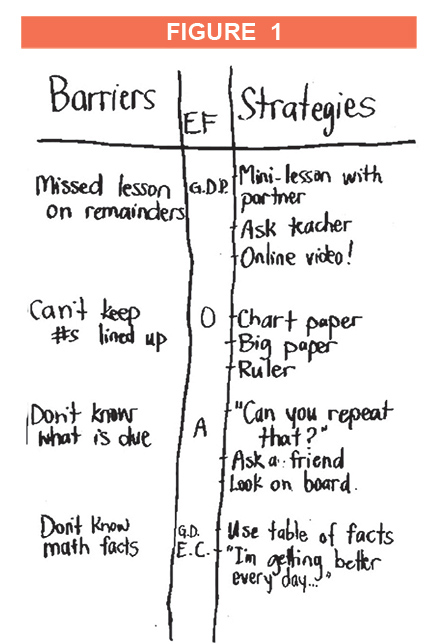Teaching Executive Skills in Middle School
Attention Magazine October 2020
The Barriers & strategies protocol
 In 2019, based on thousands of opinions from community members, parents, teachers, and students, the York Region District School Board in Ontario, Canada, formulated a multi-year strategic plan. While these plans can be difficult to achieve, the board recently piloted a classroom approach that moved both teachers and students in a productive direction. This article will share the basics of the Barriers & Strategies Protocol intervention and discuss the ways it has steered us toward our objectives.
In 2019, based on thousands of opinions from community members, parents, teachers, and students, the York Region District School Board in Ontario, Canada, formulated a multi-year strategic plan. While these plans can be difficult to achieve, the board recently piloted a classroom approach that moved both teachers and students in a productive direction. This article will share the basics of the Barriers & Strategies Protocol intervention and discuss the ways it has steered us toward our objectives.
York Region District School Board: Multi-Year Strategic Plan (2019)
- Build safe and inclusive learning and working environments where students and staff feel they matter and belong.
- Develop the knowledge, skills, and attitudes to remove barriers in support of all learners.
- Build trust and collaborative relationships with students, families, and staff through respectful and responsive communication focused on shared solutions.
- Elevate student voice in learning, assessment, and decision-making.
The approach
Let’s back up a few years, to 2017. Sue Ball, chief psychologist, along with the superintendent and principal of student services within the York Region District School Board (YRDSB), met with Laurie Faith, former educator and PhD student at the University of Toronto. During several meetings, Dr. Ball and the student services team at the YRDSB explored Faith’s idea to first teach children about their executive functions (attention, working memory, initiation, inhibition, organization, time management, planning, flexibility, persistence, and emotional control) and then to use this literacy within whole-class conversations about the barriers and strategies for learning.
The goal was to provide teachers with a new option for responding to struggling students. Where, typically, a teacher might respond to off-task behavior by expressing disapproval, providing external regulation, or adjusting expectations, Faith suggested the use of a short, semi-structured protocol to facilitate socially supported learning regulation: the Barriers & Strategies Protocol. It replaces external learning regulation that is guided by the voice, autonomy, and competence of a teacher, with socially supported regulated learning that is guided by the voice, autonomy, and competence of the students in the class.
For example, after assigning Grade 6 division problems and seeing students struggling, a teacher would gather the group together to ask, specifically, “What are your barriers to this work?” and “What might we do to be strategic and successful?” In the following discussion, the teacher would help students connect identified barriers and strategies to underlying executive functions, an attribution process that, when conducted regularly, reinforces EF literacy and helps students demystify and manage new challenges.
You can see how a teacher would record student responses on a whiteboard or flip chart in Figure 1. These charts can be collected in the classroom for easy reference, so students can reflect upon favorite strategies and transfer them from one subject or challenge to another.
Benefits of the approach
Hold the preceding scenario about independent work in mind and read over our strategic plan; the Barriers & Strategies Protocol checks a lot of boxes. Interrupting teachers’ rushed interpretations of classroom problems creates space for substantive and personal conversations about learning. Especially when teachers and students are “EF-literate,” they can appreciate the huge and often unanticipated variety of factors that may be impacting performance.
After asking about barriers to independent work, for example, a teacher might hear, “I think I can do the problems. I just didn’t hear all of your instructions, so I’m confused about which ones are due. That’s an attention problem.” Another student might say, “I’m nervous because I know I can’t keep all the numbers lined up neatly. That’s organization.” A final student might comment that members of the basketball team missed the class on remainders. The teacher may think, Really? I’m glad I asked!
As the Barriers & Strategies Protocol moves toward strategies, a variety of students can share creative strategies for managing attention, organization, and using goal-directed persistence to catch up on missed skills. In this way, students build familiarity and fluency with the types of executive functions that tend to impact their performance, and the types of strategies that they tend to prefer.
This approach is beneficial for all students. It protects against stigma and exclusion, because conversations are open, inclusive, and focused on the idea that struggles at school are natural, normal, and manageable. Students can see that everyone needs support, everyone can grow, and everyone can succeed. In addition, they can enjoy a healthy rapport in their classroom, feeling as though their voice, ingenuity, and contributions are valued. While not everyone will speak up during the Barriers & Strategies protocol, those who aren’t ready to participate actively will build self-regulatory skills through safe observation and imitation of their more involved peers.
Along with the elevation of student voice and sense of mattering, shifting learning regulation toward a socially supported approach provides teachers with a lot more information. Without this process, the Grade 6 teacher might have resorted to shortening the assignment, hollering, “Okay, Sixes, just do the first three questions!” Or, the teacher may have called the whole class to the carpet to repeat the instructions more slowly. In both cases, her intervention may have been suitable for some, inappropriate for some, and downright frustrating for still others.
By placing data-gathering directly into daily pedagogy, teachers have immediate access to the personal, behavioral, and contextual information needed to be responsive and collaborative. The process elevates student voice in learning, assessment, and decision-making. It allows whole communities to work together to develop knowledge, skills, and healthy attitudes, and remove barriers for all learners.
The feasibility of this approach matters. The teaching of self-regulated learning is notoriously difficult for teachers to implement. Using a semi-structured protocol scaffolds learning for both students and teachers on a continuous basis throughout the day. It provides many safe opportunities to grow and take up the reigns as a supportive and capable community of learners. Experts agree, increasing the variety and frequency of direct training of self-regulated learning moves students more quickly toward independent transfer of these skills.
Our pilot study
We piloted this approach in 21 junior-level classrooms in our linguistically, culturally, and neurologically diverse board. Participating teachers were treated to a full day of training, and were then supported in short, regular, small-group videoconferences. Our research services department followed the project, administering semi-structured focus groups among students and teachers.
We were excited by the results. Generally, our students gained an understanding of their own EF strengths and weaknesses and felt more prepared and less stressed when faced with challenges. One student explained that “It helped [her] so much, a bunch of things [she] struggled with before, [she] learned strategies and [she] no longer struggles with them now.” Another said, “If you don’t have strategies, it helps you because you can know more strategies and get better at things.” To students, the focus on strategies seemed “really important.”
The teachers felt that it boosted inclusivity. “It promotes greater understanding amongst students and teachers about individual differences,” one commented. Another noted that the approach was empowering because it emphasized that “we can all improve, and we grow with time and practice.” One principal remarked that she “didn’t get any feedback from staff about how this was another add-on piece, which often happens.” Rather, “[teachers] were like, this is very useful, it’s practical, it’s something that [teachers] can see and measure almost immediately because they saw it in themselves.”
In many ways, our pilot project moved our board in the direction of our strategic plan. Teachers made fundamental pedagogical change, learning new ways to understand students and support their learning. Our next steps are to expand the number of teachers participating within pilot schools, include resource teachers and special education consultants, build in-house capacity for initial training, and to continue to uncover evidence of change though collaboration with our research department. Furthermore, we hope to continue sharing our learning with innovative, supportive communities like CHADD.

Figure 1. Flip chart notes made during the use of the Barriers & Strategies Protocol. Underlying executive functions, as suggested by the class team, are listed in the middle column. Legend: GDP = goal-directed persistence, O = organization, A = attention EC = emotion control


